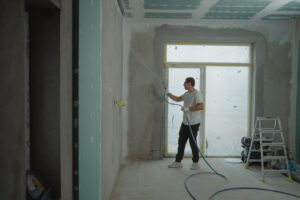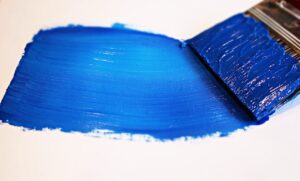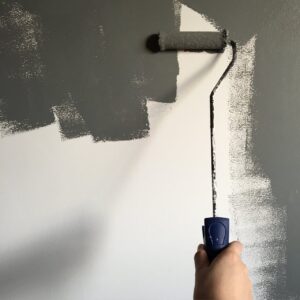
How to Choose Textured Paints for Different Room Types
Imagine walking into a room that instantly captivates your attention. The walls are not just flat and plain, but they possess a unique texture that adds depth and character to the space. Textured paints have the power to transform any room, creating an atmosphere that is visually intriguing and full of personality. But how do you choose the right textured paint for different room types? Discover the benefits of textured paints, learn how to test for compatibility with different surfaces, and get practical tips for selecting textured paints that enhance the appearance of your interior areas. Discovering Textured Paints and Their Advantages Textured paints offer both aesthetic and practical benefits. They can help hide imperfections on walls, creating a smooth and flawless finish. These paints add a unique visual appeal to any room, making it stand out from the ordinary. One of the significant advantages of textured paints is their ability to conceal wall imperfections. Whether it’s small cracks or uneven surfaces, textured paints can effectively mask these flaws, giving your walls a clean and polished look. This makes them an excellent choice for older homes or rooms with less-than-perfect walls. Moreover, textured paints come in various finishes, allowing you to achieve different effects based on your preferences. For instance, if you want a subtle texture that adds depth without overpowering the room’s overall design, you can opt for a fine sand-textured paint. On the other hand, if you desire a more pronounced texture that creates a bold statement, there are options available with larger granules or additives like crushed stone or glass beads. The versatility of textured paints extends beyond just aesthetics. They also provide practical benefits such as improved durability and ease of maintenance. The added texture helps to resist stains and scuffs better than flat paint finishes. It also allows for easier touch-ups in case of minor damages since the texture helps blend in repairs seamlessly. Identifying the Different Textures Available It’s important to understand the various texture options available. Each texture has its own distinct appearance and application method, so knowing the differences will help you make an informed decision. Numerous Texture Options There are numerous texture options to choose from when selecting a textured paint. Some popular choices include sand, popcorn, and knockdown textures. These textures can give your walls a unique and visually appealing look. Distinct Appearance and Application Method Each texture option has its own distinct appearance and requires a specific application method. For example, sand texture creates a rough and grainy surface that adds depth to your walls. It is applied using a trowel or roller, depending on the desired effect. On the other hand, popcorn texture creates a bumpy finish resembling popcorn kernels. This texture is typically sprayed onto the walls using specialized equipment. It can add character to any space but may require more maintenance due to its tendency to collect dust. Lastly, knockdown texture provides a subtle yet stylish look by creating flattened peaks on the wall surface. It is achieved by applying joint compound with a trowel and then flattening it with a knife or roller. Making an Informed Decision Understanding the different textures available allows you to make an informed decision based on your preferences and the room type you are working with. Consider factors such as lighting, furniture style, and overall ambiance when selecting a textured paint for each room. By carefully considering these factors and understanding the characteristics of each texture option, you can choose textured paints that enhance the aesthetics of your home while also reflecting your personal style. Matching Texture Types to Room Functions When choosing textured paints for different room types, it is important to consider the purpose of each room. The texture type you select can greatly impact the overall feel and functionality of a space. Here are some key points to keep in mind: Purposeful Smoothness for Formal Areas In formal areas such as living rooms or bedrooms, smooth textures are often preferred. These textures create a sleek and elegant look that complements the sophisticated atmosphere of these spaces. Smooth textured paints provide a clean and polished finish, adding a touch of refinement to your home decor. Embracing Roughness in High-Traffic Areas For high-traffic areas like hallways or children’s rooms, rougher textures may be more suitable. These textures not only add visual interest but also help to hide imperfections and withstand daily wear and tear. The roughness of the texture can make the walls more durable and less prone to damage from bumps or scratches. By selecting textured paints that align with the function of each room, you can enhance both aesthetics and practicality. Smooth textures lend an air of sophistication to formal areas, while rougher textures offer durability in high-traffic spaces. Remember that there are various texture options available, ranging from subtle patterns to bold designs. Consider your personal style preferences as well when making your selection. https://youtu.be/GFHZaxncHAk?si=_l3suzoDCtkGm0UC Factors Influencing Textured Paint Selection When choosing textured paint for different room types, there are several factors to consider. These factors will help you select the right type of textured paint that complements the overall aesthetics and atmosphere of each room. Lighting Conditions The lighting conditions in a room can greatly impact how textured paint appears on the walls. Rooms with ample natural light may benefit from lighter shades of textured paint as they can enhance the texture and create a sense of depth. On the other hand, rooms with limited natural light may benefit from darker shades of textured paint to add warmth and richness to the space. Existing Decor and Furniture Consider the existing decor and furniture in each room when selecting textured paint colors. Take into account their colors, patterns, and styles. Choose a textured paint color that harmonizes with these elements to create a cohesive look and feel throughout the space. Personal Preferences and Desired Atmosphere Personal preferences play an important role in choosing textured paints for different rooms. Consider your own taste and style when









